The woman who lost a dog and gained 200 sloths
- Published
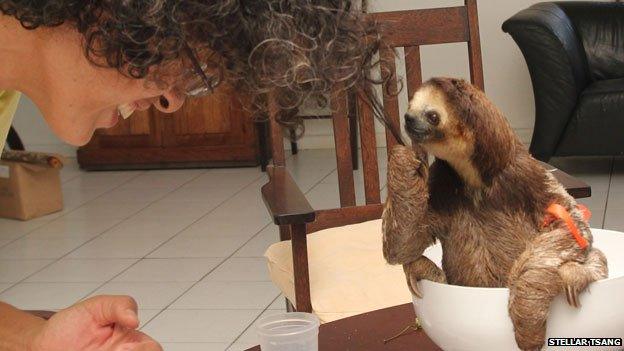
Monique Pool first fell in love with sloths when she took in an orphan from a rescue centre. Since then many sloths have spent time in her home on their way back to the forest - but even she found it hard to cope when she had to rescue 200 at once.
It all began in 2005 when Pool lost her dog, a mongrel called Sciolo, and called the Suriname Animal Protection Society to see if they'd found it. They hadn't, but they told her about Loesje (or Lucia), a baby three-toed sloth they didn't know how to look after. Pool offered to take it - and was instantly smitten. "They're very special animals to look at," she says. "They always have a smile on their face and seem so tranquil and peaceful."
Sloths are gentle creatures, but are far from easy to keep. Their diet presents enormous problems, and the local zoo had shied away from the task.
Pool sought advice from Judy Arroyo at the famous sloth sanctuary in Costa Rica, external, who told her she must feed Loesje goat's milk - cow's milk would be fatal. But goat's milk is rarely available in Suriname and had to be sent over from the US. The leaves that sloths eat are also hard to source - and must be fresh.
Loesje had a surprise in store - she turned out to be a "he". Male three-toed sloths display a characteristic spot on their backs when they're a year old. "But we carried on calling him Loesje because he was used to the name," says Pool. He was her very first charge but died after two years. "I didn't know what was wrong with him," she says. She wished she could just ask him. The experience taught her how little expertise there was in the rehabilitation and care of three-toed sloths, but she built up a network of contacts, external and hasn't had a youngster die on her since.
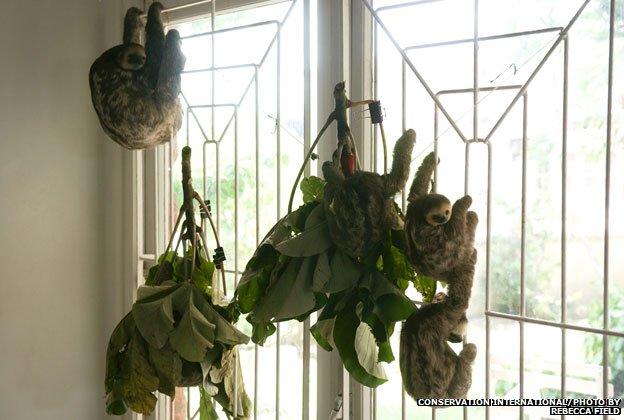
Sloths hung all over Pool's house - from the bars on the window and anything else they could grab onto
Soon Pool became the go-to woman for sloths in Suriname. If the police, the zoo or the Animal Protection Society hear about a sloth, they call her. On average, one or two sloths a week pass through her home before being released a few days later, unless they are hurt and need time to recover.
However in October 2012 Pool was faced with a crisis - "Sloth Armageddon", as she puts it. A piece of forest near the capital, Paramaribo, was being cleared and she was asked to remove 14 sloths.
"I'd never seen more than six together, so we knew we'd have a lot to cope with," says Pool. As a machine operator carefully pushed over the 15m (50ft) trees, the sloths in the canopy would fall to the ground, where they were picked up by Pool and her volunteers. Sloths move very slowly on the ground - even when they'd like to get away fast.

The baby sloths are weighed regularly to check their progress
A friend built enclosures in Pool's back garden for the adults. "There were so many of them it was hard to open the cage and keep them all in," she says. "As soon as they saw the doors open they'd try and get out." At night, males would sometimes fight and have to be separated. "Normally sloths are solitary animals," Pool says. "So to be so packed together was not a normal situation for them." And they keep to different timetables - two-toed sloths are awake at night and three-toed sloths by day - so they had to be housed separately.
Four days into the rescue they realised they were dealing with more than 14 sloths - a lot more. "After a month we were close to 100, and at the end we got to 200," says Pool. "On some days I had 50 animals at my house. We had 17 babies at one point, being fed with droppers by volunteers." Pool had managed to source a steady supply of powdered goat's milk by then.
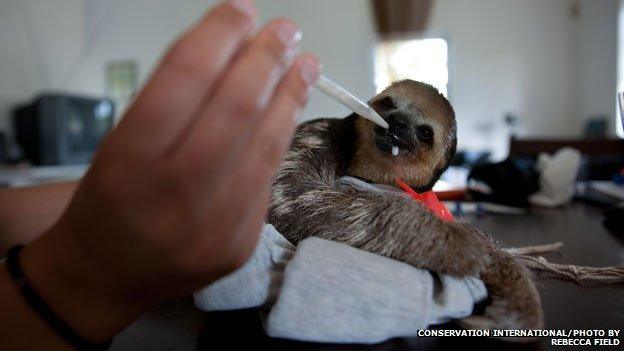
Sloths were hanging everywhere - from the trees in her back garden, from the bars on the living room window, and anything else they could hold on to. "Two female adults sat on the TV stand and the babies would climb on the matriarchs." One very young sloth, known as Lola, would pop up in the strangest places, like the stove top - though not when the gas was alight, luckily. "She was an amazing little thing," Pool says. "She didn't like to sit with the others, she preferred to hang behind the fridge where it's nice and warm."
This was when Pool invented the term "slothified" as a description for her home and life - she plans to write a book about the experience. This is how she defines it:
Slothified (adj.)
1. Overwhelmed by sloths
2. Overwhelmed by sloth - so tired after catching sloths all day that you don't want to get out of bed
3. Overwhelmed by the cuteness of sloths (baby sloths in particular)
4. Overwhelmed by sloth lovers
The one thing Pool could not do was slow down. She was at full stretch for two months, spending whole days at the forest clearance site, external, and organising teams to feed and care for all the sloths at home.
Monique Pool faced 'Sloth Armageddon' when she took in 200 rescued sloths
Luckily for the neighbours, sloths tend to be quiet - most of the time. "We had one, Bolletje (Little Ball), who was on heat and made a lot of noise to attract males," Pool says. "We'd rush into the room because we thought they were fighting. She must have cottoned on to this because later, when she was no longer on heat, she would call just to get our attention. She was very intelligent."
The hardest thing was feeding them all. Although three-toed sloths are known to eat up to 50 types of leaves, they have very different preferences depending on the area they come from - young sloths learn which leaves to eat by licking leaf fragments from their mother's lips. But luckily for Pool there is one tree all sloths eat, the cecropia. She was saved by a friend who worked in a forest resort in the interior. Every day, she sent Pool a load of fresh leaves via a bus that went back and forth with tourists. Two-toed sloths are easier to please - they will eat dagublad leaves (a relative of the sweet potato) which are sold by most greengrocers in Suriname. And they like apples.
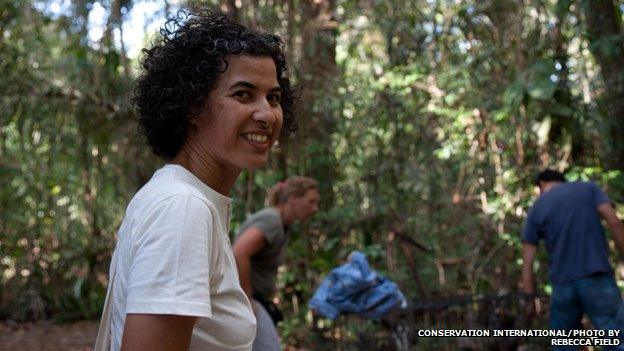
Pool is happiest when the sloths are released back into the forest
The sloth's diet explains its peculiar behaviour. Most leaves are hard to digest, so some leaf-eating animals (folivores) cope by eating huge quantities, others by regurgitating their food and repeating the digestion process. Sloths simply allow lots of time - the BBC's David Attenborough calls them "mobile compost heaps, external". As a result, they have a very slow metabolism. They save energy by hanging from their formidable claws, rather than using muscles unnecessarily. In fact, they move so slowly that they're an attractive place to live - three-toed sloths host a number of other organisms in their fur, including algae and the "sloth moth".
But sloths actually sleep less than was once thought, external - they are not lazy, despite their name. Scientists still have plenty to learn about them, as their life high in the tree canopy, combined with their slow and silent movements and effective camouflage, make them extremely hard to observe. So Pool's access to sloths presents a great opportunity - she collects blood samples and other data for Nadia De Moraes-Barros, a researcher with the Anteater, Sloth and Armadillo Specialist Group, external.
"I realised there is a lot of bad information out there," says Pool. "For example that they are slow and dim-witted, when actually they are very smart and deliberate." She finds them far from stupid - a group of sloths learned how to open the bathroom door, and one, probably a former pet, even used the toilet. "The first time we thought it was a mistake," says Pool. "But after the fourth time we realised they had taught her how to go to the toilet."
Sloths only defecate about once a week - which makes them "wonderful houseguests," says Pool. Recent studies have shone a light on their curious toilet habits. Rather than allowing their poo to fall from the tree, as the two-toed sloth does, three-toed sloths make a weekly pilgrimage down to the forest floor to poo on the ground, where they are vulnerable to attack by predators - half of all sloth deaths occur on the ground. So why do they do it? It is known that this behaviour benefits the sloths' resident moths, who lay eggs in sloth dung. Scientists from the University of Madison now have a theory, external that the moths may in turn encourage the growth of luxuriant green algae on the sloth's fur. This doesn't just create excellent camouflage, the scientists think it may also be an additional food source. In other words, sloths might be farming algae in their fur, with moths providing the fertiliser.
Sloths and anteaters
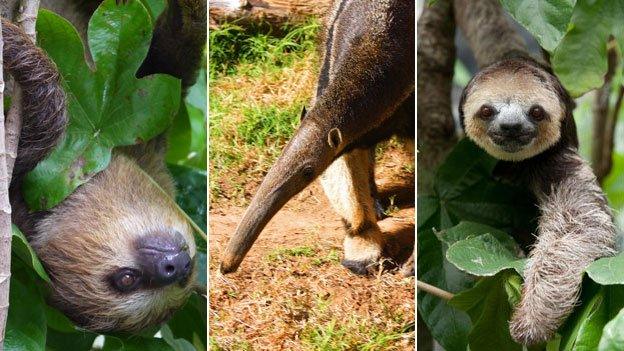
Sloths, along with armadillos and anteaters constitute the Xenarthra superorder. Two-toed sloths (left) are nocturnal. Three-toed sloths (right) are diurnal. They, and anteaters (centre), are the oldest mammals on the American continent - perhaps 60 million years old. Most species of the group are already extinct, like the Megatherium, a giant ground sloth (photos by Monique Pool, Thinkstock, Conservation International)
Many people are scared of sloths because of their claws, which look quite fearsome, but Pool has never been attacked by one, despite the traumatic circumstances in which they tend to meet. One rescued sloth, who she called Smokey, was wounded but "very kind", she says. "You wouldn't believe she was wild, she'd touch you very carefully with her toes when she wanted something. All the babies loved her too." Pool also thinks they have a degree of feeling in their claws. "Once when I was taking a three-toed sloth to the vet - she was miscarrying - she held my hand with her claw, as if she knew she wouldn't survive." She didn't.

"Harvey" the sloth was rescued after crossing a busy road - and then offered for barter on the radio
Last year, Pool took in a badly-injured two-toed sloth she named Stephane - one head wound contained 130 maggots. Stephane's arrival coincided with an international sloth conference in Suriname, and Pool jokes that he must have planned it so that the best specialists in South America were on hand to treat him. Two months later, when the wound had healed, she took him back to the area where he was found. He disappeared up a tree so fast that she was unable to capture it on film. Those are the best moments for her. "It's such a pleasure when you go with them to the forest," says Pool. "If you hold a sloth, it starts reaching out for the trees, like it's swimming with its arms - for them it can't be fast enough." The sloths are generally released an hour's drive from the capital - one site, along a river, is completely uninhabited and probably will be for many years.
All the sloths rescued during "Slothageddon" were released back into the wild, apart from three babies - now teenagers - who aren't quite ready to fend for themselves. Pool calls them "lounge sloths" because they roam freely around the house. It's a tribute to her expertise that they have survived for so long - three-toed sloths usually die after months in captivity, and it's a race against the clock to get them back to their natural environment. If new arrivals refuse to eat, Pool also lets them go - often their depression lifts when they see trees.
From June this year, most of the rescue work will be done at a new centre 67 km (42 miles) outside Paramaribo, where land has been made available by a tourism company. Meanwhile, another crisis looms. Pool has found out about a new patch of forest which is going to be cleared. The owner thinks there are 15 sloths, so Pool has calculated there could be as many as 300.
It's likely to be Slothageddon II. "I don't sleep much, it is difficult," says Pool, who fits in rescuing alongside a full-time job as a translator. It doesn't leave much room for anything else, she says. "I'm single, I haven't found the right person who is as crazy as I am."
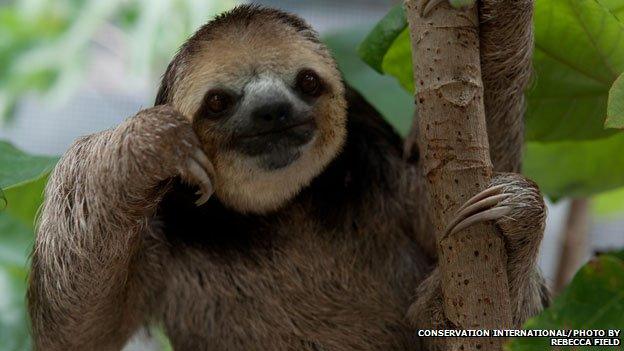

The Tao of Sloth
What would it be like to be a sloth? Human life would be a blur. Sloths seem to embody a central tenet of Taoism "action through non-action" so let's consider a "Tao of Sloth":
Eat slowly - The sloth's diet of leaves is hard to digest, their approach is to allow plenty of time
Hang out - Sloths save energy by hanging from their claws rather than using their muscles
Smile all the time - Sloths are cute and appear to smile though they're not primates, they're related to anteaters and armadillos
Be kind and others will be kind to you - Three-toed sloths climb down from the safety of the tree canopy to poo on the ground, for the benefit of moths that live in their fur (the moths in turn encourage the growth of beneficial algae)

The land was being cleared for cattle - rescuers were on hand to grab sloths as the bulldozers moved in
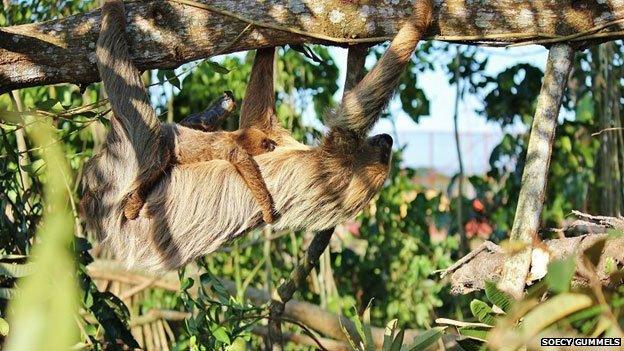
Sloths live in the tree canopy and are very vulnerable to deforestation
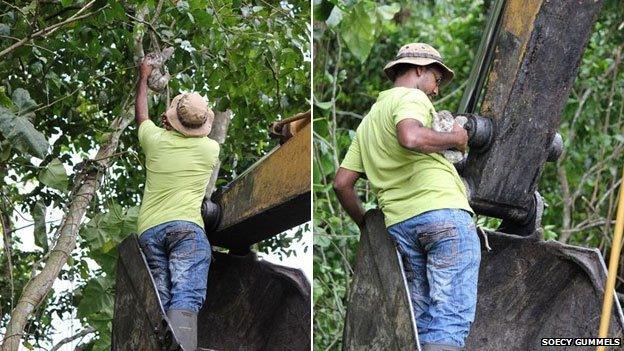
The developers worked closely with rescuers to save sloths from the forest they were clearing
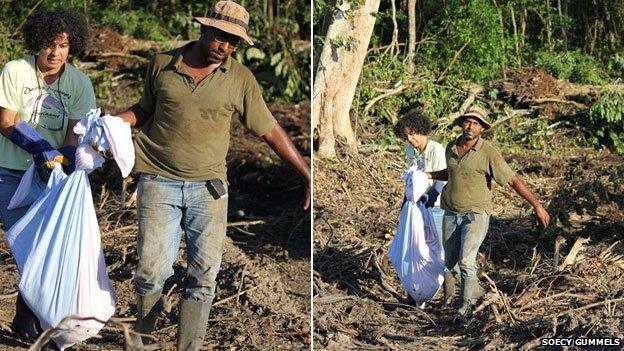
Rescued sloths were carried away from the area in sacks and boxes
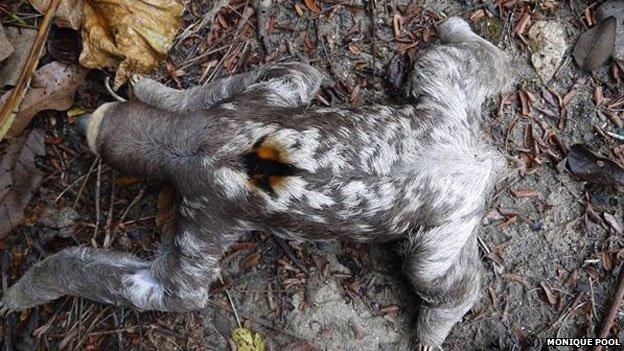
Sloths are helpless on the ground - this male shows the typical spot on his back
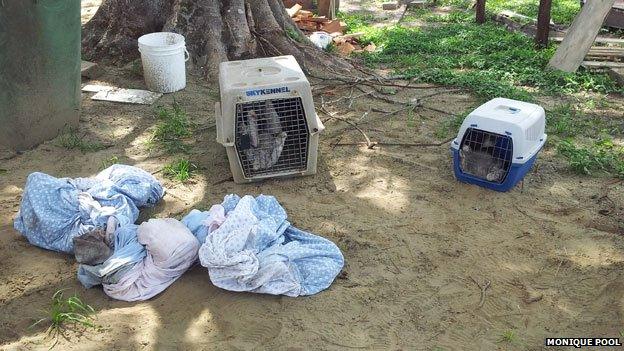
Bags full of rescued sloths wait to be taken to Pool's house
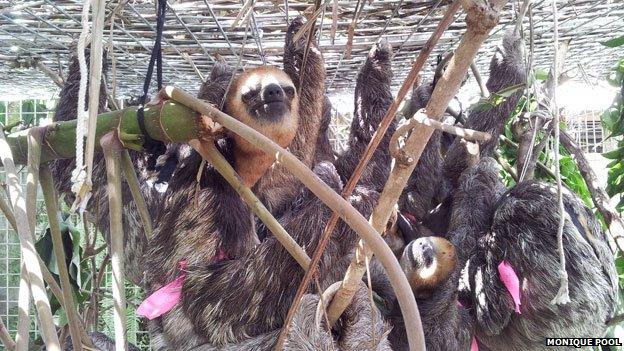
The sloths were kept in an enclosure in Pool's garden until a new home was found for them
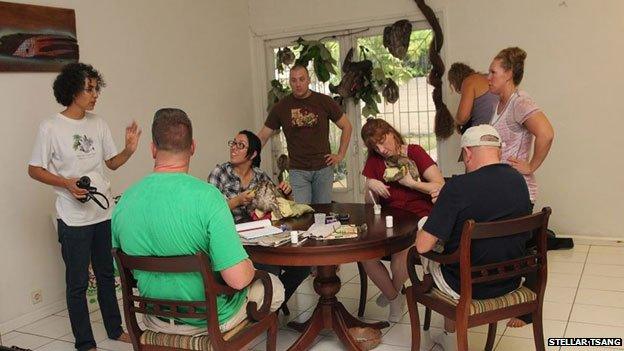
The sloths were looked after by an army of volunteers at Pool's home
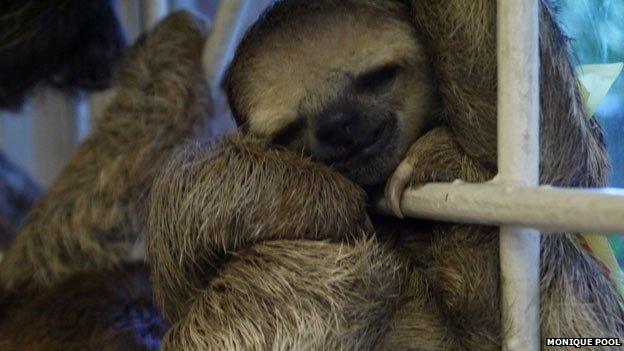
Sloth hung from the bars on the windows - and anything else they could hold on to
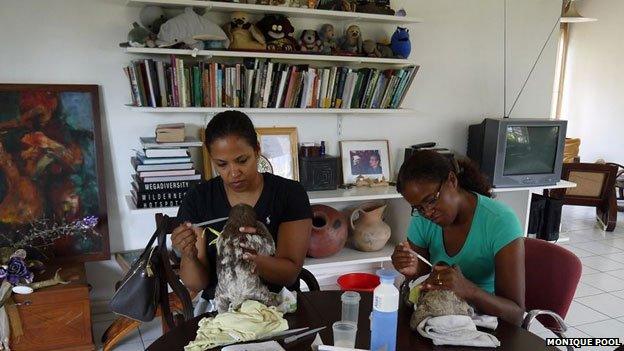
Baby sloths being fed by volunteers in Pool's house
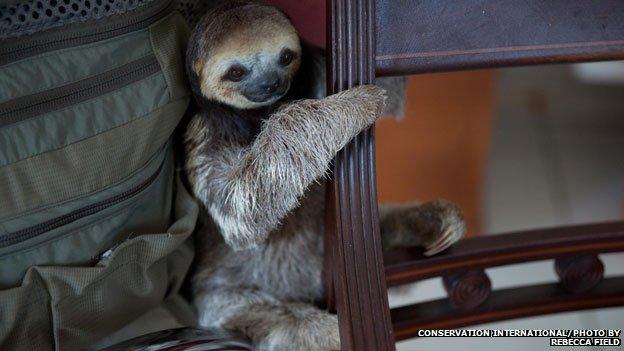
Young sloths were able to roam all over the house
Monique Pool spoke to Outlook on the BBC World Service. Listen again on iPlayer or get the Outlook podcast.
Follow @BBCNewsMagazine, external on Twitter and on Facebook, external
- Published2 March 2012